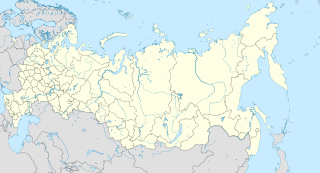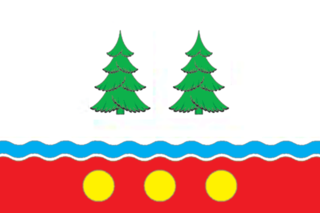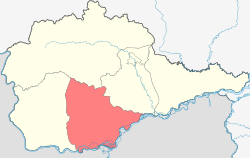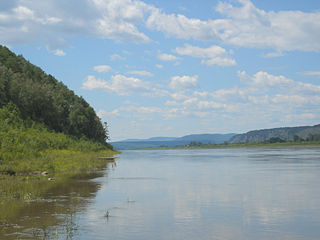
Magdagachi is an urban locality and the administrative center of Magdagachinsky District of Amur Oblast, Russia, located 367 kilometers (228 mi) northwest of Blagoveshchensk. Population: 10,897 (2010 Census); 12,208 (2002 Census); 15,578 (1989 Census).

Obluchye is a town and the administrative center of Obluchensky District in the Jewish Autonomous Oblast, Russia, located on the Amur River, 159 kilometers (99 mi) west of Birobidzhan, the administrative center of the autonomous oblast. Population: 9,379 (2010 Census); 11,069 (2002 Census); 12,016 (1989 Census).

Arkharinsky District is an administrative and municipal district (raion), one of the twenty in Amur Oblast, Russia. The area of the district is 14,355 square kilometers (5,542 sq mi). Its administrative center is the urban locality of Arkhara. Population: 17,186 (2010 Census); 21,068 ; 27,537 (1989 Census). The population of Arkhara accounts for 55.8% of the district's total population.

Konstantinovsky District is an administrative and municipal district (raion), one of the twenty in Amur Oblast, Russia. The area of the district is 1,816 square kilometers (701 sq mi). Its administrative center is the rural locality of Konstantinovka. Population: 12,986 (2010 Census); 14,847 ; 16,710 (1989 Census). The population of Konstantinovka accounts for 41.0% of the district's total population.

Mazanovsky District is an administrative and municipal district (raion), one of the twenty in Amur Oblast, Russia. The area of the district is 28,316 square kilometers (10,933 sq mi). Its administrative center is the rural locality of Novokiyevsky Uval. Population: 14,803 (2010 Census); 16,028 ; 20,393 (1989 Census). The population of Novokiyevsky Uval accounts for 29.2% of the district's total population.

Oktyabrsky District is an administrative and municipal district (raion), one of the twenty in Amur Oblast, Russia. The area of the district is 3,381 square kilometers (1,305 sq mi). Its administrative center is the rural locality of Yekaterinoslavka. Population: 19,679 (2010 Census); 22,761 ; 23,127 (1989 Census). The population of Yekaterinoslavka accounts for 49.4% of the district's total population.

Romnensky District is an administrative and municipal district (raion), one of the twenty in Amur Oblast, Russia. The area of the district is 10,066 square kilometers (3,887 sq mi). Its administrative center is the rural locality of Romny. Population: 9,401 (2010 Census); 11,822 ; 15,651 (1989 Census). The population of Romny accounts for 32.8% of the district's total population.

Selemdzhinsky District is an administrative and municipal district (raion), one of the twenty in Amur Oblast, Russia. The area of the district is 46,672 square kilometers (18,020 sq mi). Its administrative center is the urban locality of Ekimchan. Population: 11,639 (2010 Census); 11,808 ; 20,632 (1989 Census). The population of Ekimchan accounts for 10.4% of the district's total population.

Seryshevsky District is an administrative and municipal district (raion), one of the twenty in Amur Oblast, Russia. The area of the district is 3,805 square kilometers (1,469 sq mi). Its administrative center is the urban locality of Seryshevo. Population: 25,725 (2010 Census); 29,440 ; 35,969 (1989 Census). The population of Seryshevo accounts for 42.0% of the district's population.

Skovorodinsky District is an administrative and municipal district (raion), one of the twenty in Amur Oblast, Russia. The area of the district is 20,509 square kilometers (7,919 sq mi). Its administrative center is the town of Skovorodino. Population: 29,558 (2010 Census); 34,269 ; 42,998 (1989 Census). The population of Skovorodino accounts for 32.4% of the district's total population.

Smidovichsky District is an administrative and municipal district (raion), one of the five in the Jewish Autonomous Oblast, Russia. It is located in the east of the autonomous oblast and borders Khabarovsk Krai in the north and east, China in the south, and Birobidzhansky District in the west. The area of the district is 5,900 square kilometers (2,300 sq mi). Its administrative center is the urban locality of Smidovich. As of the 2010 Census, the total population of the district was 28,165, with the population of Smidovich accounting for 18.2% of that number.

Leninsky District is an administrative and municipal district (raion), one of the thirty-six in Moscow Oblast, Russia. It is located in the center of the oblast just south of the federal city of Moscow. The area of the district is 202.83 square kilometers (78.31 sq mi). Its administrative center is the town of Vidnoye. Population: 172,171 (2010 Census); 145,251 ; 74,490 (1989 Census). The population of Vidnoye accounts for 33.0% of the district's total population.

Ekimchan is an urban locality and the administrative center of Selemdzhinsky District of Amur Oblast, Russia, located on the right bank of the Selemdzha River. Population: 1,212 (2010 Census); 1,224 (2002 Census); 1,832 (1989 Census).

Lazarevo is a small town in Leninsky District in the Jewish Autonomous Oblast, Russia. It is the head of Lazarevskoye Rural Settlement.
Tambovka is a rural locality and the administrative center of Tambovsky District of Amur Oblast, Russia. Population: 7,6,173 (2010 Census); 8,147 (2002 Census); 8,828 (1989 Census).

Talakan is an urban locality in Bureysky District of Amur Oblast, Russia. Population: 5,176 (2010 Census); 6,545 (2002 Census); 4,479 (1989 Census).

Sivaki is an urban locality in Magdagachinsky District of Amur Oblast, Russia. Population: 2,056 (2010 Census); 2,578 (2002 Census); 3,721 (1989 Census).



















